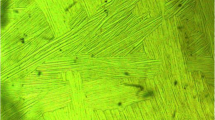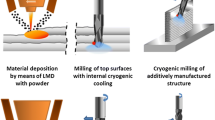Abstract
Titanium alloys are of significant importance in several high performance applications such as aerospace components or medical implants. Advances in additive technologies lead to an increase of additively built workpieces, offering new possibilities regarding functional integration and lightweight structures. Several authors have shown that microstructural, mechanical and thermal material properties differ significantly from those of cast alloys. Although additively produced parts are near net-shape, most of them are machined after the building process, to achieve the requirements regarding surface finish and dimensional accuracy. Titanium is generally known as a hardto- cut material due to its thermo-mechanical properties. Although there is a profound knowledge about the machinability of conventionally cast and wrought titanium alloys, there is a lack of understanding regarding the machining of additively built titanium. In this paper, the machinability of an additively built Ti-5Al-5V-5Mo-3Cr alloy (Ti-5553) is analyzed regarding chip formation, cutting forces and tool wear. Three different generation methods, conventional wrought, selective laser melting and selective laser melting with in-process (insitu) heat treatment are investigated. It is shown that the machinability differs significantly compared to a conventional wrought alloy, which is linked to decreased contact length on the tool rake face and higher mechanical tool load (up to + 23 % force increase). Highest tool load is found for titanium alloy, which is built using selective laser melting and in-process heat treatment. Furthermore, the surface integrity after machining is analyzed regarding hardness, roughness and residual stresses. Hereby, high compressive residual stresses for additively built titanium with in-process heat treatment are obtained due to the higher mechanical tool load. Therefore, it could be shown that the generation method (e.g. selective laser melting) needs to be considered for the later process design in finish machining.
Similar content being viewed by others
References
E. Uhlmann, R. Kersting, T. B. Klein, M. F. Cruz and A. V. Borile, Additive manufacturing of titanium alloy for aircraft components, Procedia CIRP, 15th Machining Innovations Conference for Aerospace Industry, Hanover, Germany (2015) 55–60.
B. H. Jared, M. A. Aguilo, L. L. Beghini, B. L. Boyce, B. W. Clark, A. Cook, B. J. Kaehr and J. Robbins, Additive manufacturing: Toward holistic design, Sripta Materialia, 135 (2017) 141–147.
M. K. Thompson, G. Moroni, T. Vaneker, G. Fadel, R. I. Campbell, I. Gibson, A. Bernard, J. Schulz, P. Graf, B. Ahuja and F. Martina, Design for additive manufacturing: Trends, opportunities, considerations, and constraints, CIRP Annals -Manufacturing Technology, 65 (2) (2016) 737–760.
D. Herzog, V. Seyda, E. Wycisk and C. Emmelmann, Additive manufacturing of metals, Acta Materialia, 117 (2016) 371–392.
Inside Metal Additive Manufacturing, Mechanical finishing of additively manufactured metal parts, http://www.insidemetaladditivemanufacturing.com/blog/mechanicalfinishing-of-additively-manufactured-metal-parts (2016).
B. Vrancken, L. Thijs, J. P. Kruth and J. Van Humbeeck, Heat treatment of Ti6Al4V produced by selective laser melting: Microstructure and mechanical properties, Journal of Alloys and Compounds, 54 (2012) 177–185.
A. Polishetty, M. Shunmugavel, M. Goldberg, G. Littlefair and R. K. Singh, Cutting force and surface finish analysis of machining additive manufactured titanium alloy Ti-6Al-4V, Procedia Manufacturing, International Conference on Sustainable Materials Processing and Manufacturing, SMPM 2017, South Africa, Kruger National Park (2017) 284–289.
A. Bordin, S. Bruschi, A. Ghiotti and P. F. Bariani, Anlysis of tool wear in cryogenic machining of additive manufactured Ti6Al4V Alloy, Wear, 328–329 (2015) 89–99.
S. Sartori, A. Bordin, L. Moro, A. Ghiotti and S. Bruschi, The influence of material properties on the tool crater wear when machining Ti6Al4V produced by Additive manufacturing technologies, Procedia CIRP, 7th HPC 2016 -CIRP Conference on High Performance Cutting, Chemnitz, Germany (2016) 587–590.
O. Oyelola, P. Crawforth, R. M’Saoubi and A. T. Clare, Machining of additively manufactured parts: Implications for surface integrity, Procedia CIRP, 3rd CIRP Conference on Surface Integrity, Charlotte, USA (2016) 119–122.
S. Milton, A. Morandeau, F. Chalon and R. Leroy, Influence of finish machining on the surface integrity of Ti6Al4V produced by selective laser melting, Procedia CIRP, 3rd CIRP Conference on Surface Integrity, Charlotte, USA (2016) 127–130.
D. Gu, Laser additive manufacturing of high-performance materials, First Ed., Springer Publishing Company, Berlin, Germany (2015).
S. L. Semiatin, S. L. Knisley, P. N. Fagin, D. R. Barker and F. Zhang, Microstructural evolution during alpha-beta heat treatment of Ti-6Al-4V, Metallurgical and Materials Transactions A, 34 (10) (2003) 2377–2386.
S. Zhu, H. Yang, L. G. Guo and X. G. Fan, Effect of cooling rate on microstructure evolution during a/b heat treatment of TA15 titanium alloy, Journal of Materials Characterization, 70 (2012) 101–110.
L. Thijs, F. Verhaeghe, T. Craeghs, J. Van Humbeeck and J. P. Kruth, A study of the microstructural evolution during selective laser melting of Ti-6Al-4V, Acta Materialia, 58 (9) (2010) 3303–3312.
H. Attar, M. Calin, L. C. Zhang, S. Scudino and J. Eckert, Manufacture by selective laser melting and mechanical behavior of commercially pure titanium, Journal of Material Science & Engineering A, 593 (2014) 170–177.
H. Schwab, F. Palm, U. Kühn and J. Eckert, Microstructure and mechanical properties of the near-beta titanium alloy Ti-5553 processed by selective laser melting, Materials & Design, 105 (2016) 75–80.
G. Kasperovich, H. Gherekhloo, J. Gussone, J. Hausmann and Y. C. Hagedorn, Selektives Laserschmelzen von konventionellen und intermetallischen Titanlegierungen -Eigenschaften und Optimierung, Internal Colloquium DLR, Available on http://www.dlr.de.
L. Löber, Selektives Laserstrahlschmelzen von Titanaluminiden und Stahl, Dr.-Ing. Dissertation, TU Dresden, Germany (2015).
H. Schwab, M. Bönisch, L. Giebeler, T. Gustmann, J. Eckert and U. Kühn, Processing of Ti-5553 with improved mechanical properties via an in-situ heat treatment combining selective laser melting and substrate plate, Materials & Design, 130 (2017) 83–89.
P.-J. Arrazola, A. Garay, L.-M. Iriarte, M. Armendia, S. Marya and F. Le Maitre, Machinability of titanium alloys (Ti6Al4V and Ti555.3), Journal of Materials Processing Technology, 209 (5) (2009) 2223–2230.
R. Komanduri, Some clarifications on the mechanics of chip formation when machining titanium alloys, Wear, 76 (1) (1982) 15–34.
F. Zanger, Segmentspanbildung, werkzeugverschleiss, randschichtzustand und bauteileigenschaften: Numerische analysen zur optimierung des zerspanungsprozesses am beispiel von Ti-6Al-4V, Dr.-Ing. Dissertation, KIT Karlsruhe, Germany (2012).
E. Abele and B. Fröhlich, High speed milling of titanium alloys, Advances in Production Engineering & Management, 3 (2008) 131–140.
S. A. Iqbal, P. T. Mativenga and M. A. Sheikh, A comparative study of the tool-chip contact length in turning of two engineering alloys for a wide range of cutting speeds, The international Journal of Advanced Manufacturing Technology, 42 (2009) 30–40.
S. Veeck, D. Lee, R. Boyer and R. Briggs, The castability of Ti-5553 alloy, Advanced Materials & Processes, 162 (10) (2004) 47–49.
J. C. Sabol, T. Pasang, W. Z. Misiolek and J. C. Williams, Localized tensile strain distribution and metallurgy of electron beam welded Ti-5Al-5V-5Mo-3Cr titanium alloys, Journal of Materials Processing Technology, 212 (11) (2012) 2380–2385.
H. Matsumoto, M. Kitamura, Y. Li, Y. Koizumi and A. Chiba, Hot forging characteristic of Ti-5Al-5V-5Mo-3Cr alloy with single metastable β microstructure, Materials Science and Engineering: A, 611 (2014) 337–344.
C. Y. Yap, C. K. Chua, Z. L. Dong, Z. H. Liu, D. Q. Zhang, L. E. Loh and S. L. Sing, Review of selective laser melting: Materials and applications, Applied Physics Reviews, 2 (4) (2015).
V. Brackmann, V. Hoffmann, A. Kauffmann, A. Helth, J. Thomas, H. Wendrock, J. Freudenberger, T. Gemming and J. Eckert, Glow discharge plasma as a surface preparation tool for microstructure investigations, Materials Characterization, 91 (2014) 76–88.
N. G. Jones, R. J. Dashwood, M. Jackson and D. Dye, β-Phase decomposition in Ti-5Al-5Mo-5V-3Cr, Acta Materialia, 57 (13) (2009) 3830–3839.
R. Panza-Giosa, The effect of heat treatment on the microstructure evolution and mechanical properties of Ti5Al5V-5Mo3Cr, and its potential applications in landing gears, McMaster University (2009).
G. Lütjering and J. C. Williams, Titanium, Second Ed., Springer Berlin Heidelberg, Berlin, Heidelberg (2007).
J. C. Williams, B. S. Hickman and H. L. Marcus, The effect of ω-phase on the mechanical properties of titanium alloys, Metallurgical Transactions, 2 (7) (1971) 1913–1919.
P. J. Arrazola, T. Özel, D. Umbrello, M. Davies and I. S. Jawahir, Recent advances in modelling of metal machining processes, CIRP Annals -Manufacturing Technology, 62 (2) (2013) 695–718.
C. Gey, Prozessauslegung für das Flankenfräsen von Titan, Dr.-Ing. Dissertation, University Hanover (2002).
Author information
Authors and Affiliations
Corresponding author
Additional information
Recommended by Associate Editor Yongho Jeon
Berend Denkena is the Director of the Institute of Production Engineering and Machine Tools (IFW).
Alexander Krödel is team leader in the Department “Cutting processes” at the IFW.
Rights and permissions
About this article
Cite this article
Grove, T., Denkena, B., Maiß, O. et al. Cutting mechanism and surface integrity in milling of Ti-5553 processed by selective laser melting. J Mech Sci Technol 32, 4883–4892 (2018). https://doi.org/10.1007/s12206-018-0936-8
Received:
Revised:
Accepted:
Published:
Issue Date:
DOI: https://doi.org/10.1007/s12206-018-0936-8




